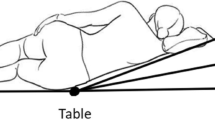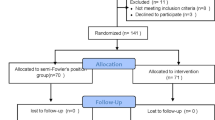Abstract
Background
The lateral position is known to be advantageous for maintaining airway patency. This study compared the lateral and supine positions for tracheal extubation in pediatric patients when performing deep extubation.
Objective
The hypothesis was that tracheal extubation in the lateral position would improve airway obstruction that often occurs immediately after extubation and can be a practical method.
Material and methods
This prospective randomized trial was performed in operating rooms in a tertiary care hospital and included 92 patients (3–12 years old) undergoing elective strabismus surgery. The patients were randomly divided into two groups: deep extubation in the supine position (group S) and deep extubation in the lateral position (group L). Oxygen saturation (SpO2) and the incidence of stridor, laryngospasm, and coughing after tracheal extubation were assessed.
Results
The mean ± standard deviation of the lowest SpO2 values within 5 min after extubation was significantly higher in group L (98.3 ± 2.1%) than in group S (96.8 ± 2.5%, mean difference 1.5, 95% confidence interval, CI 0.5–2.5, p = 0.003). The incidences of stridor and laryngospasm of group L were significantly lower than those of group S (1/45, 2% vs. 8/45, 18%, respectively; relative risk 1.9, 95% CI 1.4–2.7, p = 0.03). The incidence of desaturation and coughing were not significantly different between groups.
Conclusion
In pediatric patients deep extubation in the lateral position improved SpO2 and reduced the incidence of stridor and laryngospasm in the early emergence period when compared to extubation in the supine position.
Zusammenfassung
Hintergrund
Die seitliche Position ist als vorteilhaft für die Aufrechterhaltung der Durchgängigkeit der Atemwege bekannt. In dieser Studie wurden die laterale Position und die Rückenlage für die trachealen Extubation bei pädiatrischen Patienten bei tiefer Extubation verglichen.
Ziel der Arbeit
Die Hypothese lautete, dass eine Trachea-Extubation in Seitenlage eine praktische Methode darstellen kann, da sie die Atemwegsobstruktion verbessern würde, welche häufig unmittelbar nach der Extubation auftritt.
Material und Methoden
Diese prospektive randomisierte Studie wurde in Operationssälen in einer Tertiärklinik durchgeführt und umfasste 92 Patienten (3–12 Jahre), die sich einer elektiven Strabismusoperation unterzogen hatten. Die Patienten wurden zufällig in 2 Gruppen eingeteilt: tiefe Extubation in Rückenlage (Gruppe S) und tiefe Extubation in Seitenlage (Gruppe L). Die Sauerstoffsättigung (SpO2) und die Häufigkeit von Stridor, Laryngospasmus und Husten nach trachealer Extubation wurden bewertet.
Ergebnisse
Der Mittelwert ± Standardabweichung der niedrigsten SpO2-Werte innerhalb von 5 min nach Extubation war in Gruppe L (98,3 ± 2,1 %) signifikant höher als in Gruppe S (96,8 ± 2,5 %) (mittlere Differenz 1,5; 95 % Konfidenzintervall [KI] 0,5–2,5; p = 0,003). Die Inzidenz von Stridor und Laryngospasmus der Gruppe L war signifikant niedriger als die der Gruppe S (1/45 [2 %] vs. 8/45 [18 %]; relatives Risiko: 1,9; 95 % KI 1,4–2,7; p = 0,03). Die Häufigkeit von Entsättigung und Husten unterschied sich nicht signifikant zwischen den Gruppen.
Schlussfolgerung
Bei pädiatrischen Patienten verbesserte die tiefe Extubation in Seitenlage den SpO2-Wert und verringerte die Inzidenz von Stridor und Laryngospasmus in der frühen Erholungsphase im Vergleich zur Extubation in der Rückenlage.


Similar content being viewed by others
References
Reber A, Paganoni R, Frei FJ (2001) Effect of common airway manoeuvres on upper airway dimensions and clinical signs in anaesthetized, spontaneously breathing children. Br J Anaesth 86:217–222
Crawford MW, Arrica M, Macgowan CK et al (2006) Extent and localization of changes in upper airway caliber with varying concentrations of sevoflurane in children. Anesthesiology 105:1147–1152 (discussion 1145A)
von Ungern-Sternberg BS, Davies K, Hegarty M et al (2013) The effect of deep vs. awake extubation on respiratory complications in high-risk children undergoing adenotonsillectomy: A randomised controlled trial. Eur J Anaesthesiol 30:529–536
Rassam S, Sandbythomas M, Vaughan RS et al (2005) Airway management before, during and after extubation: A survey of practice in the United Kingdom and Ireland. Anaesthesia 60:995–1001
Arai YC, Fukunaga K, Ueda W et al (2005) The endoscopically measured effects of airway maneuvers and the lateral position on airway patency in anesthetized children with adenotonsillar hypertrophy. Anesth Analg 100:949–952
Litman RS, Wake N, Chan LM et al (2005) Effect of lateral positioning on upper airway size and morphology in sedated children. Anesthesiology 103:484–488
Kelly AS, Barlow SE, Rao G et al (2013) Severe obesity in children and adolescents: identification, associated health risks, and treatment approaches: A scientific statement from the American Heart Association. Circulation 128:1689–1712
Popat M, Mitchell V, Dravid R et al (2012) Difficult Airway Society Guidelines for the management of tracheal extubation. Anaesthesia 67:318–340
Hampson-Evans D, Morgan P, Farrar M (2008) Pediatric laryngospasm. Paediatr Anaesth 18:303–307
Arai Y‑CP, Fukunaga K, Hirota S et al (2004) The effects of chin lift and jaw thrust while in the lateral position on stridor score in anesthetized children with adenotonsillar hypertrophy. Anesth Analg 99:1638–1641
Walsh JH, Leigh MS, Paduch A et al (2008) Effect of body posture on pharyngeal shape and size in adults with and without obstructive sleep apnea. Sleep 31:1543–1549
Hartley M, Vaughan RS (1993) Problems associated with tracheal extubation. Br J Anaesth 71:561–568
Baijal RG, Bidani SA, Minard CG et al (2015) Perioperative respiratory complications following awake and deep extubation in children undergoing adenotonsillectomy. Paediatr Anaesth 25:392–399
Klučka J, Štourač P, Štoudek R et al (2015) Controversies in pediatric perioperative airways. Biomed Res Int. https://doi.org/10.1155/2015/368761
Hillman DR, Platt PR, Eastwood PR (2003) The upper airway during anaesthesia. Br J Anaesth 91:31–39
Nozaki-Taguchi N, Isono S, Nishino T et al (1995) Upper airway obstruction during midazolam sedation: Modification by nasal CPAP. Can J Anaesth 42:685–690
Batra YK, Ivanova M, Ali SS et al (2005) The efficacy of a subhypnotic dose of propofol in preventing laryngospasm following tonsillectomy and adenoidectomy in children. Paediatr Anaesth 15:1094–1097
Gulhas N, Durmus M, Demirbilek S et al (2003) The use of magnesium to prevent laryngospasm after tonsillectomy and adenoidectomy: A preliminary study. Paediatr Anaesth 13:43–47
Author information
Authors and Affiliations
Corresponding author
Ethics declarations
Conflict of interest
H. Jung, H.J. Kim, Y.-C. Lee and H.J. Kim declare that they have no competing interests.
Trial registration: http://www.who.int/ictrp/network/cris2/en/, CRIS, KCT0002570. Registered 1 December 2017.
Rights and permissions
About this article
Cite this article
Jung, H., Kim, H.J., Lee, YC. et al. Comparison of lateral and supine positions for tracheal extubation in children. Anaesthesist 68, 303–308 (2019). https://doi.org/10.1007/s00101-019-0590-2
Received:
Revised:
Accepted:
Published:
Issue Date:
DOI: https://doi.org/10.1007/s00101-019-0590-2




